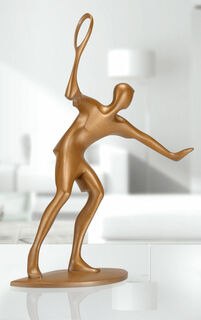Sculpture "Tennis Player", bronze
Sculpture "Tennis Player", bronze
Quick info
limited, 49 copies | numbered | signed | bronze | chiselled | patinated | size 33 x 25 x 11 cm (h/w/d) | weight approx. 3.4 kg
Detailed description
Sculpture "Tennis Player", bronze
The game of tennis thrives on its dynamism. It is fast and requires the highest concentration from both players during every rally. Of course, this is especially true when the player has to calculate and prepare his return to an opponent's stroke in a matter of seconds. Mücke shows this moment; a blink of an eye later, the player knows how to react.
Edition in bronze, cast using the Lost-Wax-Process, chiselled and patinated by hand. Limited to 49 numbered and signed copies. Size 33 x 25 x 11 cm (h/w/d). Weight approx. 3,4 kg.
About Torsten Mücke
The German sculptor Torsten Mücke, born in 1964, finds the models for his symbolic sculptures both among people and in the animal world. The trained goldsmith and metal sculptor has developed a very individual visual language in which he reduces the features of his objects to the necessary. In this way, he emphasises their essence and allows them to become universal symbols.
An alloy of copper with other metals (especially with tin) used since ancient times.
When casting bronze, the artist usually applies the lost-wax technique which is dating back more than 5000 years. It's the best, but also the most complex method of producing sculptures.
First, the artist forms a model of his sculpture. It is embedded in a liquid silicone rubber mass. Once the material has solidified, the model is cut out. The liquid wax is poured into the negative mould. After cooling down, the wax cast is removed from the mould, provided with sprues and dipped into ceramic mass. The ceramic mass is hardened in a kiln, whereby the wax flows out (lost mould).
Now we finally have the negative form, into which the 1400° C hot molten bronze is poured. After the bronze had cooled down, the ceramic shell is broken off and the sculpture is revealed.
Now the sprues are removed, the surfaces are polished, patinated and numbered by the artist himself or, to his specifications, by a specialist. Thus, each casting becomes an original work.
For lower-quality bronze castings, the sand casting method is often used which, however, does not achieve the results of a more complex lost-wax technique in terms of surface characteristics and quality.
Term for an art object (sculpture, installation), which is produced in multiple copies in a limited and numbered edition according to the artist‘s will.
Artist's multiples have been called the most accessible and affordable art on the market.
A plastic work of sculptural art made of wood, stone, ivory, bronze or other metals.
While sculptures from wood, ivory or stone are made directly from the block of material, in bronze casting a working model is prepared at first. Usually, it is made of clay or other easily mouldable materials.
The prime time of sculpture after the Greek and Roman antiquity was the Renaissance. Impressionism gave a new impulse to the sculptural arts. Contemporary artists such as Jorg Immendorf, Andora, and Markus Lupertz also enriched sculptures with outstanding works.









